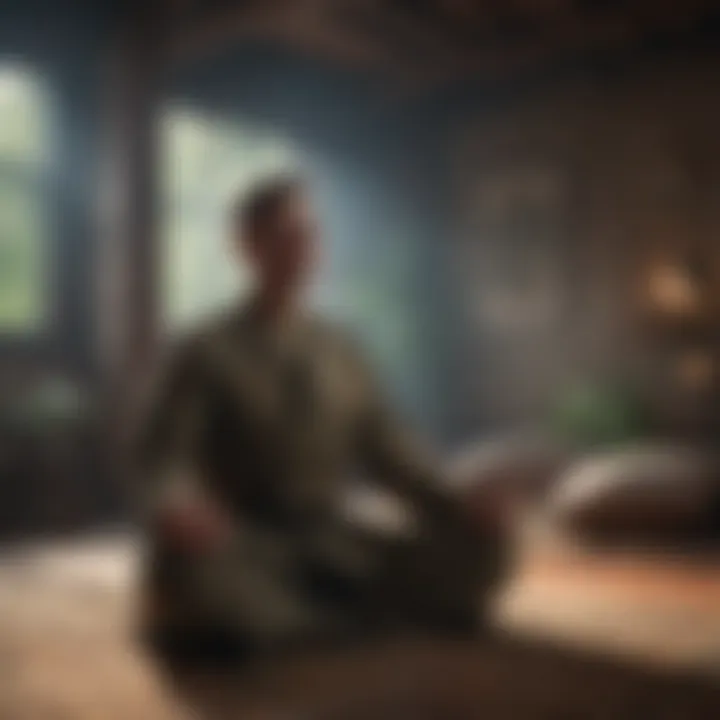Mastering Sleep: The Military Method to Quick Rest


Intro
Sleep, often considered a luxury in today’s fast-paced world, is an essential component of overall health yet evades many. The military has developed a method to achieve rapid sleep onset, championed not just for its effectiveness in the field but its broader applicability to civilian life. In this guide, we will explore the intricacies of this technique, unpacking its physiological and psychological underpinnings while offering practical advice tailored for you.
As we dive into the benefits of mastering this military sleep method, it’s crucial to appreciate how sleep, often overlooked, profoundly impacts our daily performance. Whether you’re a health professional, a wellness coach, or someone keen on optimizing well-being, understanding these principles can lead to richer, restorative sleep.
Key Benefits
Falling asleep quickly is more than a convenience; it is a gateway to numerous health benefits. Let’s break down some of the key gains one can expect from incorporating this disciplined approach into their nightly routine.
Physical Health Benefits
- Enhanced Recovery: Quality sleep allows for the body’s repair mechanisms to kick in, fostering muscle recovery and growth and reducing the risk of injury. When sleep is compromised, the body scrambles to heal, often resulting in fatigue and increased susceptibility to illness.
- Weight Management: Studies have shown that adequate sleep helps regulate hormones like ghrelin and leptin, which play key roles in hunger and appetite. Soldiers utilize efficient sleep strategies to maintain their weight and physical fitness, a method that can benefit anyone.
- Stronger Immune System: A well-rested body enhances its ability to fend off infections. During deep sleep, the immune system releases cytokines, proteins that help combat infection and inflammation.
Mental Well-being Enhancements
- Improved Focus and Concentration: The military technique is designed to clear the mind, allowing for quick access to a restful state. This is particularly valuable for anyone needing to stay sharp and alert in demanding situations.
- Reduced Stress and Anxiety: Engaging in strategic breathing and mental relaxation mimics stress-reduction techniques leveraged in combat training, effective in calming the mind and reducing tension. Better quality sleep also contributes to emotional stability and mood regulation.
- Increased Resilience: Just as soldiers need to adapt on the fly, employing effective sleep strategies can enhance one’s adaptability to daily challenges. Improved mental acuity leads to better problem-solving abilities and a more composed response to stress.
"Sleep is the best meditation." – Dalai Lama
Through these benefits, the military’s approach to sleep not only addresses the immediate need for rest but sets the stage for improved health and performance in various life aspects.
Practical Tips
Now that we understand the importance of masterful sleeping techniques, let’s delve into some practical tips to implement the military method effectively. These suggestions are straightforward, allowing anyone to integrate them into a daily routine to enhance sleep quality.
Effective Meal Planning
- Plan Ahead: Aim for a balanced diet rich in nutrients. Don’t let food choices become a last-minute scramble; plan meals that incorporate lean proteins, complex carbohydrates, and healthy fats. For instance, grilled chicken with quinoa and a side of veggies can be a fulfilling sleep-promoting meal.
- Limit Stimulants: Reduce caffeine and sugar intake, particularly in the hours leading up to bedtime. Instead, consider herbal teas like chamomile or peppermint, which can promote relaxation.
Quick and Efficient Workouts
- Incorporate Daily Movement: Engaging in regular physical activity not only tires the body but elevates mood, thanks to the release of endorphins. Aim for at least 30 minutes of moderate exercise most days of the week.
- Mindful Practices: Consider integrating yoga or even a brisk walk focused on breathing and mindfulness. These practices lay the groundwork for relaxation, preparing the mind for sleep.
By embracing these practices alongside the military sleep strategy, individuals can work toward improving sleep quality, enhancing overall well-being, and nurturing a pathway towards a healthier lifestyle.
Intro to the Military Sleep Method
When it comes to sleep, adopting a structured and disciplined approach can be the difference between a restful night and tossing and turning until dawn. The Military Sleep Method is a tactical strategy honed by the armed forces that aims to help individuals fall asleep swiftly, regardless of their environment. This method not only caters to soldiers who often find themselves in challenging conditions but can also benefit civilians grappling with the stresses of daily life.
One of the standout features of the Military Sleep Method is its focus on both physiological and psychological elements. By understanding how the body responds to stressors and how to create a conducive sleeping environment, followers of this approach can significantly improve their sleep quality. It’s about retraining the mind and body to relax, even when external conditions might suggest otherwise. The military way emphasizes that sleep is not merely a luxury but a crucial part of overall health, directly impacting performance and productivity.
Origins in Military Training
The roots of the Military Sleep Method lie deep in the rigorous training regimens that soldiers undergo. Sleep is often compromised during boot camp and combat scenarios, leading to the development of techniques that allow rapid sleep onset under duress. Historically, this method was designed to optimize the performance of troops who require quick recovery between missions. The methods have evolved over years, transferring military discipline into civilian practice.
All across military literature, emphasis is placed on the need for adequate rest. High-stakes environments necessitate maintaining alertness while simultaneously being able to rest effectively. Soldiers learn to fall asleep in less than ideal conditions, reinforcing the idea that no achievable sleep is out of reach if approached systematically with the right mindset and techniques.
Importance of Sleep for Performance
Sleep serves as the bedrock for cognitive and physical performance, making its quality paramount. In high-pressure situations, a lack of sleep can cause lapses in judgment, reduced reaction time, and decreased tolerance to stress. From elite athletes to busy professionals, sleep is the cornerstone that supports optimal functioning.
Engaging in the Military Sleep Method can lead to benefits that touch multiple aspects of life, from enhancing mood to considerably boosting concentration levels. Proper sleep fosters better decision-making and quicker learning abilities, which are critical attributes whether in military operations or daily tasks.
Benefits of Quality Sleep:
- Improved Cognitive Function: Sharpens thinking and problem-solving skills.
- Enhanced Physical Performance: Vital for athletes and fitness enthusiasts alike.
- Better Mood Regulation: Reduces irritability and supports emotional health.
- Strengthened Immune Function: Aids in fighting off common illnesses.
In essence, by mastering the Military Sleep Method, individuals can position themselves for better overall performance, reminiscent of how soldiers thrive under pressure through disciplined training and rest.
Thus, as we delve deeper into the Military Sleep Method, we will explore the science of sleep and its stages, effective techniques, and methods to optimize your sleep environment. Each step will be woven into a narrative aimed at fostering understanding and practical application for improved sleep health.
Understanding Sleep and Its Stages
Understanding sleep and its stages is crucial for grasping how the military sleep method aids in rapid sleep onset. Sleep isn’t just a break from reality; it’s a complex process that influences our physical and mental well-being. Recognizing the nature of sleep stages and cycles helps individuals optimize their sleep patterns, which in turn fosters better overall health and productivity.
The Science of Sleep Cycles
Sleep is divided into several cycles, typically lasting about 90 minutes each. These cycles can vary in number throughout the night, often totaling four to six cycles. Fundamentally, there are two main types of sleep: Non-REM (Rapid Eye Movement) and REM. Non-REM sleep breaks down into three stages, each serving distinct functions:
- Stage 1 (Light Sleep): This is the transition from wakefulness to sleep. Brain waves start to slow down, and one can easily be awoken during this phase. It’s a fleeting stage, usually lasting just a few minutes.
- Stage 2 (Moderate Sleep): Here, the body temperature drops, and heart rate slows. This stage represents about 50% of our total sleep time. It’s during stage 2 that the brain begins to produce sleep spindles and K-complexes, which help protect sleep and enhance memory.
- Stage 3 (Deep Sleep): Often considered the most rejuvenating stage, deep sleep is critical for physical recovery. The body repairs tissues and boosts immune function. Waking up during this stage can lead to grogginess, highlighting its importance.


Lastly, REM sleep, which occurs later in the cycle, is when dreams happen. Brain activity mimics that of being awake, and this phase plays a vital role in emotional regulation and memory consolidation. Understanding these stages empowers individuals to target their sleep strategies more effectively.
The Role of REM and Non-REM Sleep
Both REM and Non-REM sleep are pivotal, each contributing to essential processes necessary for optimal functioning.
Non-REM Sleep Benefits:
- Restoration: The body engages in repair and growth during this time. Hormones like growth hormone are released, supporting recovery from daily stressors.
- Cognitive Processing: It aids in the retention of new information, making it beneficial for learning.
REM Sleep Benefits:
- Emotional Processing: This stage facilitates the management of emotions, helping to process daily experiences and traumas. Notably, lack of REM can lead to irritability and difficulty in handling stress.
- Creative Problem Solving: Research suggests that REM sleep may enhance creativity and problem-solving abilities by allowing the brain to explore new associations.
In summary, each stage of sleep offers unique benefits, and a disruption in these cycles can affect numerous aspects of health and wellness. By promoting understanding of these stages, individuals can appreciate the need for a structured sleep routine, as advocated by the military method, leading to improvements in sleep quality and overall life satisfaction.
"Sleep is the best meditation." – Dalai Lama
Utilizing this knowledge, one can employ the military sleep method more effectively. This allows an individual not only to fall asleep quicker but also to enjoy deeper and more restorative sleep.
The Military Method Explained
The Military Method emphasizes the significance of structured techniques in achieving quick and effective sleep. Developed primarily for soldiers operating under strict conditions, this method highlights how discipline and specific strategies can lead to better rest, even in high-pressure situations.
The core premise is that sleep isn’t just a passive state but rather a skill that can be honed through practice and proper technique. Those who master this method find numerous benefits, from enhanced focus and alertness to improved overall health. By understanding the nuances of the Military Method, individuals can apply these principles to their own lives and potentially overcome their own battles with sleep.
Step-by-Step Guide
Here's a closer look at the step-by-step process that the Military Method proposes:
- Get comfortable: Find a quiet spot, whether it be your bedroom or a retreat center. The environment should support relaxation, making it easier to unwind.
- Relax your face: Begin by consciously relaxing the muscles in your face, particularly around the eyes, mouth, and jaw. Feel the tension melt off.
- Drop your shoulders: Let your shoulders sag and release any tightness in your neck. This helps combat that weighty burden that stress can place on our bodies.
- Calm your arms and legs: Similarly, focus on each limb individually, intentionally loosening tension. Picture them as heavy as lead sinking into the mattress.
- Breathe slowly: Inhale deeply through your nose, hold for a moment, and exhale through your mouth. Think about each breath carrying away fatigue and anxiety.
- Clear your mind: Once the body is relaxed, visualize a peaceful scenario or a calming location such as a serene beach or tranquil forest.
- Repeat if necessary: If you find yourself still awake after trying this for around 10 minutes, repeat the cycle until sleep takes over.
By following these steps diligently, many discover they can doze off much quicker than usual.
Key Techniques Used in the Method
Numerous techniques form the backbone of the Military Method. Here are a few crucial strategies:
- Visualization: Imagine a soothing place, eliminating any distracting thoughts. The mind's ability to focus on calming images aids in shifting the mental state necessary for sleep.
- Breathing exercises: This anchors participants in the present and can regulate heart rate. By focusing only on breathing, it's easier to slip away from negative thoughts that keep us awake.
- Progressive relaxation: This involves tightening and then relaxing specific muscle groups, which in turn reduces overall bodily tension.
"Consistent practice of these techniques can turn the military sleep method into a reliable routine, bringing structure to a chaotic world."
Implementing these methods often brings about immediate benefits, such as reduced anxiety and improved sleep quality. Understanding these key techniques is vital for those looking to adopt the Military Method into their sleep practices.
Preparation for Sleep: Creating the Right Environment
Creating the right environment for sleep is essential in mastering the art of quick onset slumber. It's not just about hitting the pillow; it’s about the atmosphere you cultivate around yourself to invite rest. Various elements contribute to your surroundings, positively influencing your ability to unwind and transition into sleep. The right setup can reduce the time it takes for you to drift off, enhancing the overall quality of your sleep.
Optimizing Bedroom Conditions
To begin, the first step involves regulating your bedroom conditions. A cool room setting usually works wonders in facilitating sleep. Experts often recommend a temperature around 60 to 67 degrees Fahrenheit (15 to 19 degrees Celsius). This helps the body lower its internal temperature, signaling that it’s time to sleep. Adding to this, your choice of bedding also plays a pivotal role; breathable materials like cotton or linen can help maintain comfort.
Also, consider the colors on your walls and furnishings. Soft, soothing hues can evoke a sense of calm, making the environment conducive for relaxation. Dark shades, such as deep blues or grays, create a serene atmosphere, while vibrant colors might be too stimulating.
Another fundamental aspect is lighting. Dimming the lights as bedtime approaches sends signals to your brain that it’s time to wind down. Some people favor blackout curtains to eliminate light from outside, which is a great tactic. The less light you have, the easier it can be to fall asleep.
Reducing Distractions and Noise
Distractions can wreak havoc on your efforts to achieve a speedy transition to sleep. This includes anything from electronic devices to sounds of nature or city life outside your window. To mitigate these distractions, consider investing in a white noise machine or a fan that provides a consistent sound which can drown out sudden noises. Alternatively, you might find it helpful to use earplugs that fit comfortably in your ears.
Moreover, remember that screens emit blue light that disrupts your body's natural sleep signals. It’s best to halt the use of devices at least an hour before you plan to go to sleep. Establishing a no-tech zone in the bedroom can also be beneficial in avoiding those disruptive notifications that might keep your mind active.
By making these adjustments to your environment, you not only create a peaceful sleeping sanctuary but also pave the way for a quicker and more restful sleep experience. As many a savvy sleeper knows, the environment is just as vital as the routines you set for yourself.
"The tiniest detail in your sleeping space can make the largest impact on your slumber quality."
In summation, focusing on optimizing your bedroom conditions and minimizing distractions can significantly enhance your ability to fall asleep quickly. By employing these strategies, you set a firm foundation on which you can build a better night’s rest.
Incorporating Relaxation Techniques
In the realm of sleep mastery, understanding the significance of relaxation techniques is paramount. The modern world bombards individuals with stimuli, stressors, and screens that can make sleep feel elusive. Thus, integrating effective relaxation methods can play a pivotal role in achieving rapid sleep onset. These techniques not only calm the mind but also prepare the body for rest, transforming an otherwise restless night into a sanctuary of rejuvenation.


Incorporating relaxation techniques into a sleep routine serves several purposes:
- Reduction of Anxiety: Tools like breathing exercises alleviate the tension that anxiety creates. When the mind gets tangled in worries, falling asleep can feel like trying to catch smoke with bare hands.
- Enhancing Calmness: Engaging in practices such as progressive muscle relaxation helps release physical tightness, allowing the body to enter a state more conducive to rest.
- Mind-Body Connection: The focus on relaxation techniques cultivates an awareness of one’s body signals, leading to better understanding and management of stress.
These techniques offer a multitude of benefits, assisting not just in falling asleep faster but also in improving sleep quality over time. With regular practice, they can significantly mitigate the barriers that disrupt restful sleep.
Breathing Exercises for Calmness
Breathing exercises are one of the simplest yet most effective techniques for fostering tranquility before sleep. These exercises emphasize controlled breathing, which not only soothes the nervous system but also sends signals to the body that it is time to wind down. Here’s a couple of popular methods you might find useful:
- 4-7-8 Technique: Inhale through the nose for four seconds, hold the breath for seven seconds, and exhale slowly through the mouth for eight seconds. Repeat this cycle for at least four times.
- Diaphragmatic Breathing: Place one hand on your chest and the other on your abdomen. Breathe in deeply through your nose, allowing your belly to rise. Exhale through the mouth slowly. Aim for a cycle that lasts twice as long for the exhale compared to the inhale.
These breathing exercises promote a relaxed state, providing a bridge between an active mind and restful sleep. The rhythmic nature of breathing helps create a calming ritual, enabling individuals to transition smoothly into slumber.
Progressive Muscle Relaxation
Progressive muscle relaxation (PMR) is another technique that entails a systematic approach to reducing tension throughout the body. This method involves focusing on different muscle groups, alternating between tension and relaxation.
Here is how PMR typically unfolds:
- Find a Quiet Space: Ensure that your environment is comfortable and free from distractions.
- Close Your Eyes: This will enhance focus on internal sensations.
- Tense and Relax: Start with your feet. Tense the muscles for about five seconds, then relax them fully for 30 seconds. Notice the difference between tension and relaxation. Move up to your calves, thighs, and so on, all the way up to your face and head.
- Breathe Deeply: Maintain a slow, rhythmic breathing pattern throughout the process.
This technique not only acts as a powerful stress reliever but also leads to increased bodily awareness, which is essential for fostering sleep. By reflexively acknowledging tension in muscles, PMR can effectively lower overall stress levels, aiding the body in its quest for restful slumber.
“Practicing relaxation techniques like breathing exercises and PMR sets the stage for faster sleep onset, ultimately leading to improved overall health.”
The incorporation of these simple yet profound techniques into evening routines is a step towards achieving a more disciplined approach to sleep, where the body and mind are treated to a well-deserved respite.
Psychological Preparedness for Sleep
Psychological readiness for sleep is not just a suggestion, it’s a vital aspect that can determine how quickly one can drift off to dreamland. Just like a soldier prepares mentally before heading into the field, individuals can benefit greatly from mental strategies tailored for a good night’s sleep. This preparedness encompasses two main elements: mindset and visualization techniques. Both work hand in hand to foster a suitable mental state for efficient sleep.
Mindset and Its Impact on Sleep
To put it plainly, the right state of mind can make or break your attempt to get some quality shut-eye. A tense, racing mind isn’t conducive to sleep; rather, it resembles a busy highway at rush hour, filled with noise and distractions. Here are some key points to consider about mindset:
- Creating a Sleep-Friendly Attitude: Cultivating a positive attitude towards sleep can transform one's experience. Instead of viewing bedtime as a chore or a struggle, it can help to shift the perception to see it as a relaxing and necessary ritual.
- Acknowledging Stressors: Recognizing sources of stress and letting go of them before bed is pivotal. Keeping a journal can help. Writing down thoughts or worries is like tossing excess baggage before a flight - it lightens the load and can lead to smoother takeoff into sleep.
- Setting Realistic Expectations: Understanding that sleep may not always come immediately is important. Keep in mind that trying too hard to sleep can ironically make it even more elusive. Instead, approach the process with a mindset aimed at relaxation rather than pressure.
Research indicates that individuals with a calm and positive attitude toward their sleep tend to fall asleep faster and experience a more restful night. It’s as if they invite sleep rather than chase after it.
Visualization Techniques
Enter the world of visualization, where imagination meets relaxation. This powerful technique involves picturing serene and calming images or scenarios, gently ushering the mind away from daily stress and chaos. Here’s how to harness the power of visualization:
- Choosing Calming Scenarios: Select imagery that induces tranquility. It could be imagining a peaceful beach, the gentle rustle of leaves in a quiet forest, or floating clouds in a bright blue sky. The details matter here; the more vivid the picture, the higher the effect.
- Guided Imagery: Some prefer guided practices, which you can find in various audio or app formats. These resources gently guide the listener through a scenario, allowing them to relax and focus on calming their minds.
- Consistency Matters: Just like practicing any new skill, making visualization a regular part of your pre-sleep routine can yield the best results. Over time, the brain starts associating these peaceful images with sleep, making it easier to unwind.
"The mind is everything. What you think you become." - Buddha
Introducing visualization techniques can shift one’s mental gears from a busy day to a peaceful night. With regular practice, this method can become a critical component of a well-rounded sleep strategy.
Common Obstacles to Rapid Sleep Onset
Understanding the common hurdles that impede the ability to fall asleep quickly is vital for anyone looking to adopt the military sleep method. As effective as the approach may be, individuals will frequently encounter specific obstacles that can derail their efforts toward achieving that restful slumber. Whether it's the chaos of daily life or the internal struggles of one's mind, identifying and managing these disruptions is key to mastering the art of sleep. Recognizing and addressing these obstacles is more than just an afterthought; it plays a crucial role in maximizing the benefits of the military method.
Stress and Anxiety Management
Stress is like a wet blanket on a cozy fire; it dampens the warmth and comfort that sleep provides. In the fast-paced world we live in, anxiety has become a common companion. Everyday worries about work deadlines, personal relationships, or unforeseen challenges can create a mental cacophony that makes it incredibly hard to drift off to sleep. Instinctually, the body may adopt a fight-or-flight response, putting the mind in overdrive when it's time to relax.
To manage stress effectively, one might find it beneficial to adopt techniques that center their thoughts and calm the nervous system. Here are a few practical tips:
- Deep Breathing: Engage in deep, slow breaths; this can signal the brain to switch from a state of alertness to relaxation.
- Journaling: Write down thoughts and worries before bed. This acts as a release and often helps in organizing one’s feelings.
- Establishing Boundaries: Limiting work emails or stressful conversations before bed can create a more peaceful evening routine.
"Anxiety is like a rocking chair; it gives you something to do but gets you nowhere."
Implementing a consistent stress management routine can help in transitioning from a state of anxiety to one of calmness, which is vital for effective timing into the military sleep method.
Overcoming Sleep Disruptors
Sleep disruptors come in various forms, from ambient noise to internal thoughts that prevent a seamless transition into slumber. Let's consider several common issues that can get in the way:
- Noise: External sounds such as traffic, talking neighbors, or even a ticking clock can interfere with falling asleep.
- Technology: The blue light emitted from screens can trick the brain into thinking it should stay awake, thus delaying sleep onset.
- Caffeine and Diet: Consuming caffeine too late in the day or heavy meals prior to bedtime can sabotage a good night’s rest.


To combat these disruptors, one might implement certain strategies such as:
- Sound Masking: Using white noise machines or calming music can create an enveloping soundscape that drowns out interruptions.
- Screen Time Limits: Committing to turning off devices at least an hour before bed can prepare the mind for rest.
- Mindful Eating: Paying attention to food choices and timing can prevent unwanted sleep disruptions caused by digestive issues.
By tackling these barriers head-on, one can pave the way for a smoother facilitation into the desired peace of sleep. Awareness of the common obstacles and actively seeking solutions can significantly enhance the journey of mastering sleep, allowing the military method to shine through vividly.
Additional Techniques to Enhance Sleep Quality
Enhancing sleep quality goes beyond the basics like maintaining a cool room or cutting caffeine before bed. To truly master sleep, especially through the military method, additional techniques can be a game-changer. These techniques not only help individuals fall asleep faster but also ensure that the sleep they get is restorative. It’s like ensuring all gears of a watch are perfectly aligned; when everything works in harmony, the result is a smooth, reliable sleep pattern.
Establishing a Sleep Routine
A consistent sleep routine is crucial for quality rest. The body craves regularity like a plant needs sunlight. Establishing a schedule can synchronize the internal clock, making it easier to drift off and wake up without feeling groggy. Here are some vital points to consider:
- Fixed Sleep and Wake Times: Going to bed and waking up at the same time every day, even on weekends, cultivates a pattern that fosters better sleep.
- Pre-Sleep Rituals: Engaging in calming activities such as reading, gentle stretching, or listening to soothing music helps signal to the body that it's time to wind down.
- Limit Stimulants: Caffeine and electronic devices can significantly disrupt the attempt to fall asleep quickly. It’s advisable to steer clear of these at least an hour before sleep.
Taking time to wind down creates a buffer, turning off the mental chatter of the day. As a side note, jotting down worries or tasks in a notebook can help clear the mind before trying to sleep.
Mindfulness and Meditation Practices
Mindfulness isn’t just a buzzword; it’s a practice with solid scientific backing. Employing mindfulness and meditation can dramatically improve the ability to fall asleep quickly. Let’s explore how this plays out:
- Breath Awareness: Simple focus on breath can settle a racing mind. Inhale deeply through the nose, hold for a count, then exhale slowly through the mouth.
- Body Scan Meditation: This technique involves mentally scanning each part of the body for tension and consciously relaxing those areas. It’s similar to checking for leaks in a boat; ensuring each part is in a good state leads to a smoother journey.
- Guided Imagery: Visualizing peaceful scenes or settings can distract the mind from intrusive thoughts. Think of it as a mini-vacation for the brain—each breath can take you a step deeper into relaxation.
These mindfulness techniques aren’t just quick fixes; they build resilience over time, making it easier to handle days that are stressful, thereby enhancing sleep quality.
Establishing a routine and integrating mindfulness practices may take time, but with consistent effort, remarkable changes can be observed in sleep patterns and overall well-being.
Overall, embracing these additional techniques creates a more optimized approach to sleep. It’s essential for health professionals and wellness coaches to incorporate this knowledge into their practices, providing clients with tools that truly address the nuances of sleep challenges.
Evaluating the Effectiveness of the Military Method
Understanding how effectively the military sleep method works is key for anyone seeking to enhance their sleep quality. This section examines crucial elements that contribute to the success of this approach.
Sleep, it’s often said, is the cousin of death; it’s essential yet frequently overlooked. The military method, with its roots in rigorous training, presents a structured approach that can be adapted by anyone aiming to improve their nightly rest. As we dissect the effectiveness, we will look at how tracking progress and making personal adjustments play fundamental roles in refining one’s ability to fall asleep swiftly.
Tracking Sleep Progress
To grasp if the military method is yielding the desired benefits, one must actively track sleep progress. By doing this, patterns emerge, revealing insights into your sleep quality and duration. Here are some effective methods to track your sleep:
- Sleep Diaries: A simple yet informative tool. Keep a log documenting sleep onset times, awakenings, and feelings upon waking. This encourages accountability.
- Apps and Technology: Utilize sleep tracking applications such as Sleep Cycle or Fitbit. They provide tailored feedback based on your sleeping patterns.
- Wearable Devices: These gadgets, like Oura Ring, can monitor heart rate variability and other physiological metrics to offer a comprehensive view of your sleep quality.
"What gets measured gets managed." – Peter Drucker
By employing these methods, you can observe how well you’re adapting the military technique. The goal is to pinpoint what works and what falls short, thus allowing for meaningful reflections on your sleep habits.
Making Adjustments to Personal Practice
Once sleep progress has been tracked, the next stage is adjusting aspects of the military method to enhance your efficacy in achieving sleep. It’s a bit like tailoring a suit; one size doesn’t fit all. Here’s how you might fine-tune your approach:
- Shifting Routine: If you notice consistent difficulties in falling asleep, consider adjusting your bedtime. Everyone's sleep cycle is slightly different, so find the sweet spot that works best for you.
- Testing Techniques: Experiment with various relaxation strategies from the military approach. If breathing exercises feel ineffective, possibly try progressive muscle relaxation. It’s all about finding the right fit.
- Environmental Changes: Unwanted noise or light can be sleep thieves. Try blackout curtains or white noise machines to create an optimal sleep environment. Monitor the impact of these changes on your sleep quality.
- Weekly Reflection: Take time each week to analyze your findings. Reflect on what methods improved your sleep quality and which didn’t seem to help much.
By being methodical and self-aware, you can progressively enhance your overnight rest. The military method's proven structure combined with tailored adjustments fosters a code for more restorative sleep.
Closure: A Pathway to Better Sleep
The journey to achieving restful sleep doesn't merely end with knowing a method; it’s about incorporating those principles into daily life. As discussed throughout this article, the military approach to sleep is not just another fad—it's a rooted strategy designed for optimal performance in high-pressure environments. The focus on discipline, the significance of routine, and the added techniques for relaxation all contribute to a potent framework for enhancing sleep quality.
Adopting this military-style method leads to several pivotal benefits that cannot be overstated. First, it aids in clearing the mind, allowing for a smoother transition into sleep. Stressors and distractions can be significant hindrances to achieving restful slumber, but by employing specific techniques for mental preparedness, individuals can alleviate those obstacles. Second, as one cultivates a consistent sleep routine, the body begins to adapt, leading to enhanced sleep cycles. This not only maximizes the restorative effects of sleep but also supports overall well-being. Finally, it empowers individuals with tools to manage their emotional and psychological state, leading to a more peaceful and restorative sleep experience.
Nonetheless, anyone looking to harness these opportunities should keep in mind that changes take time. As with damming a river, it's the commitment to building that wall brick by brick that ultimately determines its success.
"A journey of a thousand miles begins with a single step."
To truly construct a pathway to better sleep, one must value the importance of consistency and personalization in their practice. Not every technique will resonate with every person, and it's essential to explore and adjust methods to fit individual lifestyles.
Summarizing Key Takeaways
- Structure Matters: Adopting routines greatly influences the speed at which one can transition into sleep.
- Mental Clarity: Techniques such as visualization and mindfulness can significantly decrease anxiety and stress, laying a solid foundation for sleep.
- Environment: Optimal sleeping conditions drastically enhance the likelihood of falling asleep quickly and staying asleep.
- Practice Makes Perfect: The more often these techniques are practiced, the more effective they become.
The takeaway is clear. Implementing a disciplined approach to falling asleep can be your ticket to improvement in all facets of life—work performance, emotional balance, and general health.
Encouragement for Consistent Practice
To derive long-term benefits from the military sleep method, it is crucial to integrate these practices into your daily routine. Think of it as training for a marathon, where persistence and gradual improvement are key. Here are a few suggestions:
- Daily Commitment: Treat sleep techniques as non-negotiable appointments. Make it a habit, much like brushing your teeth.
- Adapt and Experiment: Keep an open mind toward adjusting your methods based on your experiences. Not everything will work for everyone, and finding what truly resonates with you is vital.
- Reflect and Adjust: After a month of consistent practice, take a moment to review your progress. Are you falling asleep faster? Do you wake up feeling restored? Adjust your strategies accordingly.
- Seek Support: Sometimes it helps to have an accountability buddy. Whether it’s a family member or friend, sharing your journeys can motivate both parties to stick to their routines.
In summary, the pathway to better sleep is paved with consistency, experimentation, and adaptability. It's a journey worth undertaking for enhanced living.















